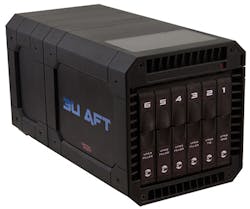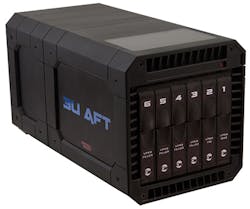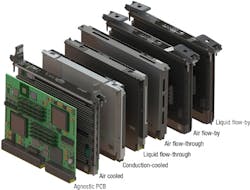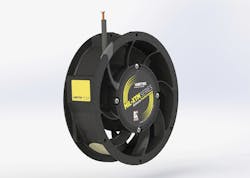Beating the heat in high-performance embedded computing
Today's high-performance processors are generating more heat than ever before, which forces embedded computing designers to take a systems approach that makes thermal management just as important as processors, circuit cards, and chassis.
Designers of high-performance embedded computing (HPEC) systems are up against a wall of heat that comes from a cascade effect of customer demands for ever-smaller size and higher performance. Typically these two factors - small size and high performance - conspire to create unprecedented amounts of heat in HPEC systems, which if not managed properly can slow down systems, reduce product life cycles, or risk catastrophic failures in military mission- and life-critical systems.
As a result, systems designers have to take much more of a high-level engineering approach than they had to 10 or 15 years ago. Electronics thermal management isn't just about blowing air or conducting heat anymore. Systems designers must consider using exotic and proprietary cooling techniques, a widening variety of standardized cooling approaches, and sometimes blending several different cooling techniques in the same system to achieve size and performance goals. At a minimum, designers no longer can consider thermal management as an afterthought.
"I've been doing thermal management for the last 20 years, and thermal engineers need to be more multidisciplinary now; know size, weight, power, and cost (SWaP-C) approaches; and work more closely with the processor designers," says Ivan Straznicky, technical fellow in the strategic planning office of the Curtiss-Wright Corp. Defense Solutions Division in Ashburn, Va.
When it comes to thermal management, there is a world of difference for embedded computing designers today than there was even a few years ago, experts say. "Today we have about 50 percent more heat to get out of the system than just five years ago," says Brian Hoden, principal mechanical engineer at Abaco Systems Inc. (formerly GE Intelligent Platforms) in Huntsville, Ala.
"Ten years ago we had to remove about 20 watts of heat from 3U-type cards, and five years ago it was 50 watts per card," Hoden says. "Now we are looking at close to 80 watts per 3U VPX card." Embedded systems generate about 1 watt of heat for each watt of power the system consumes, Hoden explains. "Power consumption on a board gets transferred to a heat load," he says. "It is about a one-to-one ratio; if a card draws 60 watts of power, you have to dissipate 60 watts of heat."
As difficult as the thermal-management challenges are for embedded systems designers, it just looks like things will get tougher in the future. "The Intel processors are getting smaller and hotter, and offer a lot more functionality; that's the trend," Hoden says. "If you can put a lot more on a board, you have to remove more heat."
With today's systems complexities, designers must consider thermal management as part of the overall system, rather than something that they can take care of near the end of the process. "Everything we do in thermal management is a systems approach," says Mike Shorey, director of mechanical engineering at Mercury Systems in Chelmsford, Mass. "The densities at the chip level have increased, the power has increased, and the size of the system has decreased. Cooling now is system level, where it used to be board level."
Getting the heat out
Removing heat from embedded computing cards and chassis, at least in theory, is limited only to the designer's imagination. Embedded systems designers can use forced air, heat conduction, a variety of liquid cooling approaches, and even refrigerated air conditioning to get heat off the cards and out of the box. Sometimes a combination of all or several of these alternatives can meet the challenge.
Practical considerations, however, quickly narrow down the designer's options. The customers who specify embedded systems have stringent requirements for small size and weight, low power consumption, and competitive pricing. This can make for a tricky balancing act.
Making the wrong choices could be disastrous. Design something that runs too hot, and processors start to throttle-back, which compromises performance. Overheated embedded systems also can cause maintenance headaches when heat-stressed components wear out more quickly than anticipated. Worse, heat can cause system failures at the worst possible times.
The bottom line is removing heat from electronics today is just as important, and just as challenging, as deciding on circuit board form factors, processors, and stiffening approaches to ruggedize boards and chassis.
"Managing the heat load is difficult, and we are having to re-evaluate how we do thermal designs to be more strategic about it," says Abaco's Hoden. "A gap pad that we used in the past won't suffice now. We are looking at heat pipes, vapor chambers, pyrolytic graphite layers, and enhanced wedge locks."
Electronics cooling for systems thermal management essentially comes down to three approaches: convection cooling, or removing heat with air; conduction cooling, or removing heat to ambient outside air; and liquid cooling, or removing heat to flowing inert fluids like 3M Fluorinert.
While these three thermal-management approaches may sound simple, the real challenges lie in the details of how engineers implement them. Creative systems designers also find that sometimes the best approaches involve blending more than one approach to electronics cooling.
Convection cooling
For many embedded computing systems managing heat with blowing air - or convection cooling - is the simplest and least expensive way to cool hot components like microprocessors. There are problems with blowing air, however - particularly when operating in environments with dirt, dust, contaminants, explosive vapors, humidity, or salt spray are present; no one wants to channel damaging elements into an embedded computer. In addition, blowing air requires moving parts like fans, which are subject to wear-out at the worst possible times.
As a result, many mission- and life-critical, convection-cooled systems require the use of redundant fans and system monitoring not only to determine if a fan has gone out, but also to track environmental conditions and predict when fans might be under heavy stress or are nearing the end of their lives. This can add to system size, complexity, and price.
There are rugged fans available, for example, from several companies like AMETEK Rotron Inc. in Woodstock, N.Y., which offers a high-output version of the company's MIL-XTM fan that is optimized for heat sink and heat exchanger thermal management applications in harsh military, aerospace, and industrial environments.
Abaco has worked together with the General Electric Research Center in Schenectady, N.Y., to invent an unorthodox, small, rugged solid-state fan called Dual Cool Jet that is a piezoelectric cooling device that moves two parallel surfaces in a kind of bellows effect to blow a small puff of air at very high velocities.
"We're looking at close to two times thermal improvement," says Abaco's Hoden. "If you could do 50 watts convection at 71 degrees Celsius, then you could increase that from 50 watts to 100 watts heat load in the chassis and still maintain 71 degrees C ambient." Dual Cool Jet technology has no spinning parts like a conventional fan, so it's very reliable, and very lightweight, Hoden says.
The piezoelectric fan measures 1.5-millimeters thick, and today is manufactured under license to GE by Aavid Thermalloy LLC in Laconia, N.H.
One convection-cooling approach for high-performance embedded computing involves the VITA 48.1 VPX standard from the VITA Open Standards, Open Markets trade association in Oklahoma City. VITA 48.1 defines embedded computing architectures using 3U and 6U VPX air-cooled circuit cards. It uses cooling air that flows directly over the components and circuit boards.
Blowing air directly over circuit cards in an embedded computing system also can require use of conformal coatings to protect sensitive electronic components from contaminants, which can add cost and complicate future systems upgrades.
A second convection-cooling approach for military HPEC systems is VITA 48.5, which defines a mechanical standard for electronic plug-in units using air-flow-through cooling. It uses a compact core heat exchanger inside the central heat sink of the unit, rather than air blown directly over the boards like VITA 48.1 does.
"A VITA 48.5 system is where you have a fan that moves air down individual card heat sinks, so you cool the center of the cards in a chassis," explains Abaco's Hoden. "The main benefit is getting the air down a heat frame so you get the air close to the hot items like processors." Abaco has delivered a full-up VITA 48.5 system "with very hot cards" to an aerospace and defense customer, Hoden says. The system has eight 6U VPX cards that generate upwards of 100 watts each.
Blended cooling
Many of today's high-performance embedded computing systems blend convection and conduction cooling. Systems designers sometimes use conduction cooling inside the chassis, move heat to the chassis wall, and then go to convection cooling by blowing air over the hot chassis walls to cool the system.
Two design guidelines with growing popularity that take this hybrid approach that blends conduction and convection cooling are the VITA 48.7 air-flow-by (AFB) cooling standard and the VITA 48.8 air-flow-through (AFT) standard.
VITA 48.7 applies to 6U and 3U VPX embedded computing boards, and uses convection heat transfer to cool plug-in modules while shielding circuit boards and backplanes from the cooling air by using plates with apertures for backplane connectors over the backplane.
VITA 48.8 AFT technology, meanwhile, applies to 3U and 6U VPX circuit cards and eliminates the use of wedge locks and ejector-injector handles, does not use module-to- chassis conduction cooling, and promotes use of new lightweight plastic or composite chassis to reduce system weight.
"Air-flow-by uses an air high- pressure differential to create high- velocity turbulent air between modules. Thermal management is built into the covers so it is a clamshell approach," explains Mercury's Shorey. Mercury is the primary developer of the technology that VITA 47 covers.
"All modules are segregated, and we have to look at the whole system to squeeze out every last bit of performance," Shorey says. "It adapts and modifies itself. Higher-perfor- mance processors get more air than the lower-power components, so it basically self-balances."
Air-flow-by technology also can enable systems designers to adapt to operating environments with low air flow, such as high altitudes, or high air flow, such as ground-level applications. "We can manage about 200 watts per slot with air flow by, and we believe we could manage over 300 watts per slot with this technology," Shorey says. "It comes down to the amount of air you have," he says, adding that limiting factors for this technology primarily are altitude and maximum ambient temperature.
A similar electronics cooling approach that blends conduction and convection cooling is VITA 48.8 air-flow-through technology. This approach also uses blown air to cool protected circuit cards, and can blend air-cooled and conduction- cooled modules in the same chassis, explains Curtiss-Wright's Straznicky.
"The air-flow-through alternative allows you to design and deploy a combination of chassis that have conduction and air-flow-through modules in the same chassis," Straznicky says. "Where you don't need the most efficient thermal management, you can use the conduction, and on the hotter boards you could use air flow through. Your DSP [digital signal processing] cards will be the high-power modules, and are perfect candidates for air flow through, while general-purpose processors, I/O cards, or switch modules could use conduction cooling."
Curtiss-Wright has demonstrated a VITA 48.8 3D-printed electronics chassis for 3U and 6U computer boards with AFT cooling. The company's 3D-printed plastic chassis is integrated with Curtiss-Wright's VPX3-1258 single-board computer and VPX3-716 graphics modules, both outfitted with AFT frames.
Curtiss-Wright designers plan to demonstrate a functional 3U AFT chassis sometime this spring that is able to run applications while cooling two VPX modules. Curtiss- Wright has delivered commercial off-the-shelf (COTS) 3U AFT embedded computing cards to its lead customer.
The advantages of a lightweight 3D-printed chassis are reduced weight for size, weight, power, and cost (SWaP-C)-constrained platforms, such as helicopters and unmanned vehicles.
VITA 48.8 also supports alternative air-flow arrangements, allowing air inlet at both card edges. Because VITA 48.8 does not use module-to-chassis conduction cooling, it also promises to help drive innovative use of new lightweight plastic or composite material-based chassis.
Conduction cooling
With all the hybrid thermal-management technologies available today, like VITA 48.7 and VITA 48.8, conduction cooling still has its place in aerospace and defense high-performance embedded computing. The implementations are changing, but the principle is the same: conduct heat away from sensitive components out to the ambient air.
One of the innovators in conduction cooling is Thermacore in Lancaster, Pa., which specializes in heat pipes, vapor chambers, and graphite, a solid material that can improve the heat-spreading properties of metal, yet is extremely light weight.
Heat pipes are sealed copper cylinders containing a small amount of water that help channel heat from hot components inside the chassis out to the edge of the chassis walls. As components heat up, the water inside the sealed heat pipe goes through evaporation and condensation cycles to move the heat, explains Greg Baldassarre, Thermacore's vice president of sales and marketing.
Another conduction-cooling alternative from Thermacore is a variant of the heat pipe called a vapor chamber, Baldassarre says. The vapor chamber is a double-walled, sealed surface with water inside that works on the same evaporation-condensation principle as the heat pipe, but is larger and more efficient at lateral spreading of heat than the heat pipe.
"The vapor chamber is one continuous chamber, rather than discrete heat pipes, which is more efficient," Baldassarre says. "It uses a top and bottom lid, but is the same principle of a sealed chamber, yet with a different geometric shape."
Vapor chambers can measure as small as a couple of inches rectangular, or could be 20 by 20 inches, Baldassarre says. In addition to its thermal characteristics, vapor chambers also can be designed rugged to resist the effects of shock and vibration in military systems. Vapor chambers and heat pipes also lend themselves to future systems upgrades because they can act as drop-in replacements for aluminum heat spreaders.
Graphite heat-spreading material, like heat pipes and vapor chambers, also can improve the heat-spreading properties of metal, yet is more lightweight than chambers or pipes.
"The biggest advantage of graphite is low mass," Baldassarre says. "Gravitational forces are not factors in graphite. It acts like metal, and is very popular in space applications because it is lightweight. It also is popular in fighter aircraft because it is impervious to G forces." The F-35 joint strike fighter uses graphite for cooling, he says.
When and where to use heat pipes, vapor chambers, and graphite depends on the system at hand. "The design tradeoffs are how far you have to distribute the heat, versus how much mass your system can tolerate. Heat pipes carry heat the farthest, vapor chambers are a little shorter, and graphite is a little shorter than that," Baldassarre says. "The lowest cost is heat pipes, then moves through vapor chambers, and then to graphite as the most expensive."
Custom solutions
Sometimes the demands for high performance in embedded computing call for custom conduction-cooling solutions for the highest-performing systems. General Micro Systems Inc. (GMS) in Rancho Cucamonga, Calif., has designed a solution called RuggedCool for use in extreme cases where standard VPX cooling simply does not work, says GMS President and CEO Ben Sharfi.
For extremely hot components like the Intel Xeon server-class chip, the GMS RuggedCool technology, which relies on liquid silver not only to move heat away from the processor, but also to cushion the processor from the effects of shock and vibration.
Essentially the RuggedCool approach uses one surface of copper, one surface of aluminum, and sandwiched in-between is a layer of silver. "We transfer heat through one side copper, and one side aluminum," Sharfi explains. "The space between the aluminum and copper we fill with liquid silver, which next to copper is the best thing to remove heat, but is not electrically conductive. Silver melts at 40 degrees Celsius, and as soon as it melts it gives you one to one-half thousandths of an inch thickness perfectly controlled. Now the heat goes from the processor to the heat spreader that connects to the silver. That transfers the heat to the aluminum, and we transfer it outward."
Using materials like liquid silver makes it clear that the RuggedCool technology is expensive, but is intended for applications for which nothing else will suffice.



